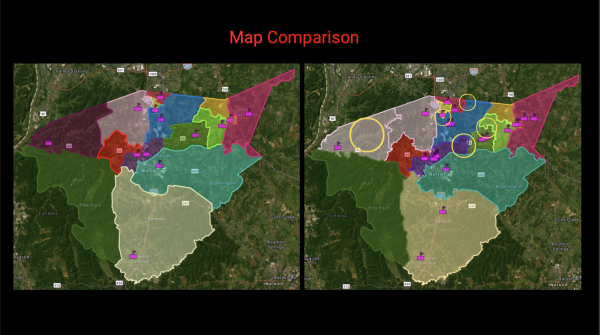To Pimp A Butterfly: The Rapper That Grew His Wings
Kendrick Lamar performs music from “To Pimp A Butterfly” in a 2016 concert.
Kendrick Lamar breaks out of his cocoon.
Snagging a Grammy in the “Best Rap Album” category in 2016, and being certified platinum by the Recording Industry Association of America, it was no accident that “To Pimp A Butterfly” received such praise to this day. Released in March 2015, Kendrick Lamar revitalizes music with the jazz hip-hop fusions that make To Pimp A Butterfly.
“To Pimp A Butterfly” takes the listener on a narrative journey through topics of fame, politics, depression and much more. His expertise in producing and writing music, along with the talents he brought for contributions to the album, reinvented rap music from the moment it was released. From the instrumentals to the rhyme schemes, the skill and genius of the album were expressed in many different ways. The reach and influence of this album have been worldwide, affecting millions of people, whether that is a producer finding inspiration in the instrumentals or production of the album, or a fan whose interpretations of the poetic lyrics lead to an appreciation for poets and rap music as a whole. The wings that this album flew with have hit new and old fans alike, impacting the music industry in unprecedented ways.
The album heavily relies on thematic elements that bridge each song together. “All of his lyrics have a deeper meaning than what you might think at first,” Kendrick Lamar fan Kortney Chappell said. Many of the meanings and lyrical subject matters reappear throughout the album, resulting in a cohesive and thematic concept album that conveys Lamar’s lyrical topics in a smooth and complete fashion.
The album begins with the song “Wesley’s Theory”. This psychedelic intro sets the stage for the album, with poetic lyrics reminiscing a romantic relationship, disguised as a metaphor for the allurement of black artists by higher-ups in the music industry for future exploitation. This is a theme that can be seen discussed lyrically throughout the rest of the album. Tracks like the feature-heavy “Institutionalized” and the experimental jazz-inspired interlude “For Free?” build on this idea of exploitation. Institutionalized discusses these issues with the feature Snoop Dogg, which further reinforces the idea of the corruption of the music industry affecting many other black artists. Promises of large wealth, fame and power from the industry with ill, selfish intentions are highlighted in the lyric, “You lookin’ at artistes like they’re harvests” from “For Free”.
The album includes character development in Lamar, with the album’s revelations and personal themes being the main focus on songs like “u”, “Alright”, and “i”. “u” is an emotional piece to the album focusing on Lamar’s deteriorating mental health due to the insecurities and failures plaguing Kendrick’s life, with talks of suicide and self-harm. “i” provides a sort of duality for the album. In contrast to “u”, “i” and “Alright” see Lamar in a place of determination and redemption from the negative portions of his life presented with songs like “u”.
Lamar is not afraid to step into politics in his music, and this album is no exception. Talks of racial injustice and police brutality are scattered all throughout the album. Songs like “The Blacker the Berry” and “i” touch on controversial topics, especially when dealing with politics pertaining to his hometown of Compton, California. Lamar describes Compton as, “A war that was based on apartheid and discrimination” in “Mortal Man”. Compton is a large conversation point of the song, with Lamar writing about feelings of survivor’s guilt of getting out of the hood. Songs like “Momma” and “Hood Politics” discuss coming back to Compton, and other songs like “King Kunta” express desires to improve Compton, and unmask injustices from Lamar’s first-hand experiences from living under Compton’s culture and government.
Progression is apparent and symbolized by the same poem Lamar recites throughout the entire album, with the first appearance of the poem only reciting the first stanza. More and more stanzas get revealed throughout the ends and beginnings of specific songs. “One of my favorite songs is Mortal Man because it shows the overall Tupac influence of the album,” Kendrick Lamar fan Tu Ho said. Mortal Man is a 12-minute song concluding the album with many of the topics spoken about throughout the album. The poem is finished in this song and reveals that throughout the entire album, the poem Lamar was reciting was to hip-hop legend, Tupac. Lamar stages an interview with his hero, Tupac. He asks Tupac his view on the topics mentioned throughout the poem and the album as a whole until the album ends its 1 hour and 18 minute run time.
Throughout the album, instrumentals mirroring like no other in Lamar’s discography complement the lyrics and theme of the album. On top of Lamar and his team’s production, artists like Pharrell and Thundercat (both Grammy award-winning artists) bring their expertise in producing songs like “Alright” and “These Walls,” as well as adapting to the album’s unique sound. “There’s a lot of jazz instrumentals in there, and influence from older music related to African American music incorporated into a modern hip hop album,” Kendrick Lamar fan Jonas Greenhalgh said. Due to the subject matter of racial injustices to African Americans, the instrumentals reflect the pride in being African American with its African American-rooted instrumental style, as well as a neo-soul, psychedelic sound that can be seen in songs like “You Ain’t Gotta Lie” and “Wesley’s Theory”. Its revolutionary sound is one of the largest takeaways of the album as a whole to many fans.
“I do production as a job, and Kendrick changed my life for the better. I might not be around if not for him and the artists I found through him,” Producer Spartan Farrar said. Farrar isn’t alone in this sentiment, as the effects and influence of this album could be felt ever since its release of the album. Praise from fans and music critics alike is apparent with the positive reviews from music critics like one of the leading music publicans, Pitchfork, calling “To Pimp A Butterfly” the fourth best album of the 2010s. General fan consensus websites like meta critic’s user score give the album an average rating of 9 out of 10.
The influence of this album lives on in many ways. Whether that be the political topics the album tackles that are still relevant to this day, or the risk-taking, experimental jazz, neo-soul and rap elements introducing his audience to a whole new sound of music. “To Pimp A Butterfly” is an album that will continue to inspire and affect new and old fans alike for years to come.






